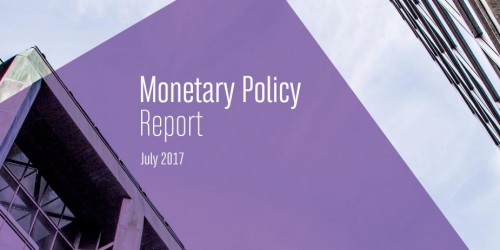Bank of Canada increases overnight rate target to 3/4 per cent
The Bank of Canada is raising its target for the overnight rate to 3/4 per cent. The Bank Rate is correspondingly 1 per cent and the deposit rate is 1/2 per cent. Recent data have bolstered the Bank’s confidence in its outlook for above-potential growth and the absorption of excess capacity in the economy. The Bank acknowledges recent softness in inflation but judges this to be temporary. Recognizing the lag between monetary policy actions and future inflation, Governing Council considers it appropriate to raise its overnight rate target at this time.
The global economy continues to strengthen and growth is broadening across countries and regions. The US economy was tepid in the first quarter of 2017 but is now growing at a solid pace, underpinned by a robust labour market and stronger investment. Above-potential growth is becoming more widespread in the euro area. However, elevated geopolitical uncertainty still clouds the global outlook, particularly for trade and investment. Meanwhile, world oil prices have softened as markets work toward a new supply/demand balance.
Canada’s economy has been robust, fuelled by household spending. As a result, a significant amount of economic slack has been absorbed. The very strong growth of the first quarter is expected to moderate over the balance of the year, but remain above potential. Growth is broadening across industries and regions and therefore becoming more sustainable. As the adjustment to lower oil prices is largely complete, both the goods and services sectors are expanding. Household spending will likely remain solid in the months ahead, supported by rising employment and wages, but its pace is expected to slow over the projection horizon. At the same time, exports should make an increasing contribution to GDP growth. Business investment should also add to growth, a view supported by the most recent Business Outlook Survey.
The Bank estimates real GDP growth will moderate further over the projection horizon, from 2.8 per cent in 2017 to 2.0 per cent in 2018 and 1.6 per cent in 2019. The output gap is now projected to close around the end of 2017, earlier than the Bank anticipated in its April Monetary Policy Report (MPR).
CPI inflation has eased in recent months and the Bank’s three measures of core inflation all remain below 2 per cent. The factors behind soft inflation appear to be mostly temporary, including heightened food price competition, electricity rebates in Ontario, and changes in automobile pricing. As the effects of these relative price movements fade and excess capacity is absorbed, the Bank expects inflation to return to close to 2 per cent by the middle of 2018. The Bank will continue to analyze short-term inflation fluctuations to determine the extent to which it remains appropriate to look through them.
Governing Council judges that the current outlook warrants today’s withdrawal of some of the monetary policy stimulus in the economy. Future adjustments to the target for the overnight rate will be guided by incoming data as they inform the Bank’s inflation outlook, keeping in mind continued uncertainty and financial system vulnerabilities.
Information note
The next scheduled date for announcing the overnight rate target is September 6, 2017. The next full update of the Bank’s outlook for the economy and inflation, including risks to the projection, will be published in the MPR on October 25, 2017.
